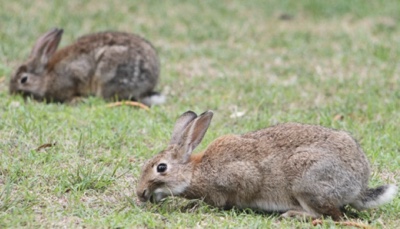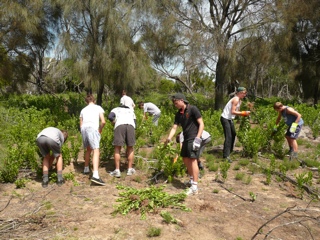Related Information
RABBITS and their effect on the land

Economic
Rabbits are prodigious eaters and will destroy pastures and crops. Rabbits are known to be very effective at spreading many weed species, further reducing productivity and creating a cost for weed control.
Environmental
More than 2 rabbits per hectare can prevent the regeneration of many native plant species, and they will ring bark many larger plants. Rabbits out-compete native fauna for habitat and food resources. Rabbits graze selectively, reducing species diversity.
Social
Rabbits don’t respect boundaries, so they are everyone’s rabbits. This means that everyone has a problem and needs to participate in their means of control. On the other hand saying “my neighbours aren’t so I won’t” is self–defeating and perpetuates a problem for land managers who are implementing control works.
Legal
The Catchment and Land Protection Act makes it an obligation for a landowner to control European Wild Rabbits. Failure to do so can result in significant fines.
Breeding Like Rabbits
Female rabbits can be continuously pregnant for 6-8 months producing an average of 28 kittens per year. Their time from giving birth to re-mating is 0.5–2 hours (hence the term “breeding like rabbits!”) Rabbits, even less than 2 months old, can disperse and feed through 1.5 to 20 km from the home warren.
Rabbit Harbour
The warren is the key to the rabbits’ defence and its Achilles Heal. Destroy the warren (which can also be under, windbreaks, burning piles, buildings, woodpiles etc) and you will destroy the rabbits’ ability to breed, re-establish and rebound.
Bridal Creeper – a weed of national significance
In 2012–2013 Batesford-Fyansford-Stonehaven Landcare received a grant for the restoration of the Dog Rocks Flora and Fauna Sanctuary from Communities for Nature through the Department of Sustainability and the Environment. The objective of this project is the removal of Bridal Creeper (Asparagus asparagoides) from the Sanctuary.
Bridal Creeper is disposed by frugivorous birds, moving water, earthmoving equipment, dumping of garden rubbish and illegal sales at markets. Bridal Creeper is a declared noxious weed under all State and territory legislation. WATCH OUT FOR IT. Contact your local Landcare group for advice about eradication.
Batesford-Fyansford-Stonehaven Landcare Group
The Batesford-Fyansford-Stonehaven Landcare Group is a small but active and committed group. It has been in existence for about 20 years and in that time, as the city has steadily started to encroach on the country in this area, the Group has reinvented itself.
Batesford Boneseed Basket-case

Boneseed removal – St Joseph‘s College students assisting
When the 83 hectare Lilydale House Sanctuary property (since renamed Dog Rocks Flora and Fauna Sanctuary) was covenanted with the Trust for Nature Victoria in 2006, the largely uncleared block had become heavily infested with boneseed. The land is of similar formation to the You Yangs, and clearly control of boneseed was of paramount importance if efforts to restore the land to its natural state were to succeed, and the vision for the covenanted property realised.
Fauna Survey
Trevor Pescott, well known and respected naturalist in the Geelong region, is conducting a Fauna Survey in the Sanctuary, the results of which will be posted later in the year.
Dog Rocks Flora and Fauna Sanctuary Vegetation Management Plan
This plan has been prepared by Mark Trengove Ecological Services and Geoff Carr of Ecology Australia. It will guide our future management of the Sanctuary situated on the western bank of the Moorabool River. (Additional information will come later.)
Vegetation and Habitat Hectare Assessment and Vegetation Management Plan for the Moorabool River Reserve, Batesford, Victoria, on behalf of the City of Greater Geelong, May 2010. Ecology Partners Pty. Ltd.
The City of Greater Geelong has prepared a Management Plan to guide the future management and development of the Council reserve adjacent to the Moorabool River at Batesford and beyond. (Additional information will come later.)

Yellow gum
